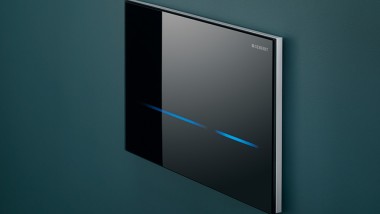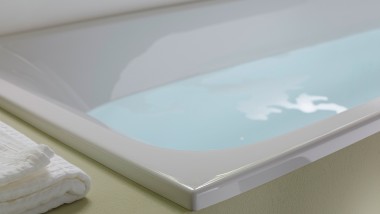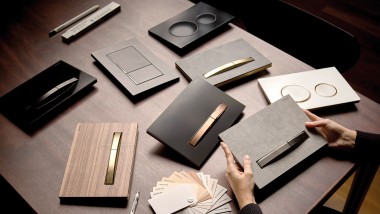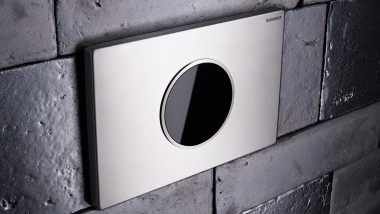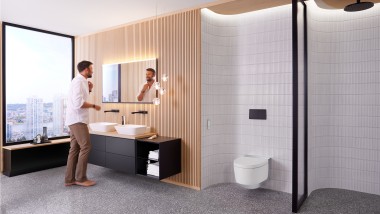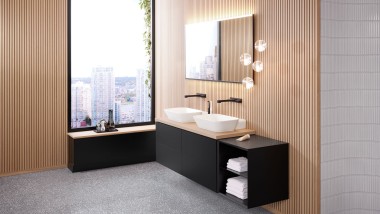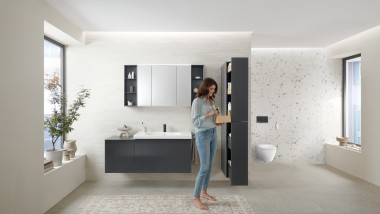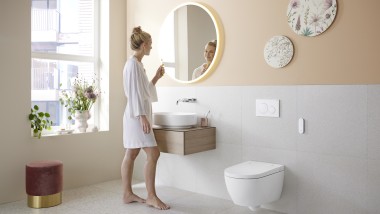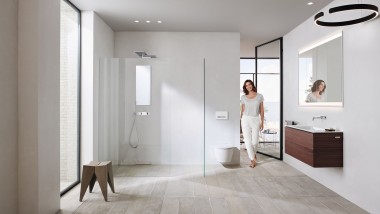Minimalist Bathroom More order in the bathroom
The architect and designer Ludwig Mies van der Rohe used a famous phrase to describe his way of constructing buildings – less is more. This motto sums up the principle of minimalism like no other.
Today, minimalism is a popular design method that works in both large and small bathrooms. We can show you the ins and outs of minimalist bathroom design.
What exactly is a minimalist bathroom?

Minimalism is all about focusing on the essentials. As a result, minimalist bathrooms are simple and rely on functional elements, such as furniture with a lot of storage space. Clear lines and a limited color scheme ensure uniformity and a calm atmosphere.
Minimalism in the bathroom does not mean dispensing with decorative aspects completely. As emphaszsed by the slow lifestyle magazine Kinfolk, simplicity at home is instead the result of clever design.
What do I really need in the bathroom?
As the bathroom is often the smallest room in the house, a minimalist design could be the perfect solution. Ask yourself what you could do without in the bathroom.
The basics are often sufficient – a washbasin with tap, a washbasin cabinet with towel rail or hook, a mirror cabinet for added storage space, a toilet and a shower or bathtub. If there is space available, additional bathroom furniture (such as a tall cabinet) can also be used for storage.
The lighting plays a significant role in creating a homely atmosphere. As a result, you should pay attention to correct lighting – both on the ceiling and at the washplace itself You can find more information in our guide.

What are the advantages of a minimalist bathroom?
First, minimalist bathrooms are practical and easy to clean. Reducing things to the essentials means fewer dust traps and improved access for cleaning. A wall-hung toilet, for example, makes it easier to clean the floor.
Anyone focusing on just essential and functional elements has more storage space at their disposal. This in turn leads to a tidy bathroom and simplifies daily routines.
Finally, a simple bathroom is also the perfect place of relaxation and retreat, offering peace and quiet for the body and soul. It’s no wonder that interior design styles such as Japandi, Wabi Sabi, and Scandi are so popular, as they focus on harmony, natural surroundings, and a minimalist look.
Three tips for designing a minimalist bathroom


Tip 1: Choose a simple, functional bathroom design
A functional bathroom design is the first step on the way to a minimalist bathroom. Choose timeless, durable furniture with additional functions. Drawers without a trap cutout offer added space, for example. To make sure the bathroom furniture looks good for a long time despite moisture in the bathroom, pay attention to the material and surface finish during purchase.
Mirror cabinets are available with useful additional functions, such as integrated lighting, power sockets, adjustable shelves, magnifying mirrors, and storage boxes for the inside of the door.
For small bathrooms without daylight, a simple idea among interior designers is to install a large mirror with integrated light above the washbasin to convey a sense of added space. This is an inexpensive way of enhancing your bathroom. Find out how a Danish architect is designing small, functional bathrooms.
Tip 2: Use simple colors
While bright colors have an invigorating effect, soft, subtle tones give a sense of calm. Typically, minimalist bathrooms are dominated by neutral colors such as white, black, and gray, plus earthy tones such as beige or brown. Uniform color schemes using shades of the same color are also an interesting option.
Natural tones and organic materials such as wood give the bathroom a warm, inviting appearance, even if designed in a minimalist way. Birch or oak are suitable for the typical Scandi style, for example. Read more tips on making a statement in the bathroom with wood. Textiles made of linen, jute, or wool and a few selected accessories such as clay pots or bamboo baskets give the bathroom a natural feel. Baskets are also a practical way of storing towels, toilet paper, or soap.
If you don’t like the color of your tiles but a renovation is too complex, then tile stickers are an inexpensive option. The self-adhesive film also works in wet rooms and can be removed or replaced with ease. Discover more tips on finding the right color.
Tip 3: Keep the bathroom tidy
Storage space is the key to a tidy, minimalist look. Below are some ideas for maintaining order in the bathroom:
- Washbasin cabinet: Organizing boxes in drawers is a good way of achieving an uncluttered washbasin cabinet. As a result, things used every day are well organized and are easy to reach. Some washbasins work with space-saving traps or, as an even better solution, the trap is installed in the wall. This allows drawers to be designed without a trap cutout, thus creating added storage space.
- Mirror cabinet: Using a mirror cabinet instead of a mirror gives additional storage space for everyday items. Mirror cabinets installed in the wall take up less space.
- Shower: Niche storage boxes are available for the shower and are installed in the wall. This creates additional, concealed shelf space. Thanks to the mirrored sliding door, shampoo, razors, and other items are not visible.
Last but not least, fewer belongings also lead to added tidiness. Why not follow the lead of Japanese expert Marie Kondo and try to declutter your bathroom? If you find it difficult to part with certain things, her famous KonMari method may be of use. Here, you get rid of things which don’t (or no longer) spark joy. Marie Kondo also has a lot of tips on the best way of storing items.



